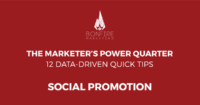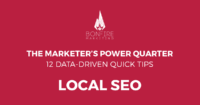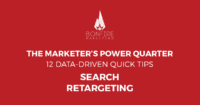There are so many different ways to organize your AdWords and Bing campaigns that it can be overwhelming at times. How you set up your campaigns really comes down to the products and services you offer. There’s definitely no one-size-fits-all method when it comes to SEM, which gives you more of a reason to set up the foundations before you get too ahead of yourself. The struggle is real! Answer these five questions and you’ll be one step closer to crafting a fully optimized SEM account.
1. Campaigns: What do you want to control budget for?
Budget is controlled at the campaign level. That means you’ll want to list out everything you want to set a budget for each day, week, month, and so on. When you’ve this listed out, you’ve officially listed out all your campaigns. Too easy, am I right? For example, if you’re selling specialty spa goods, you might want a different budget for each of your products, such as facemasks, body lotion, or essential oils. Or maybe you have multiple branches in different locations and want a dedicated SEM budget for each. Every branch would be a campaign and you would set a targeted location specific to each campaign.
One thing’s for sure: When segmenting your campaigns, always have a branded one. Branded keywords are always cheaper, but they won’t come up as often as non-branded keywords. When you mix branded and non-branded into one campaign, your non-branded keywords might not leave any budget left for branded ones. Separating them in individual campaigns will help you get more bang for your buck.
2. Ad Groups: What are all your products and services?
Answer this question for each campaign to create your ad groups. Here you’ll be breaking up your products and services with granular keywords that align with ad copy, e.g., red pens vs. green pens. If there’s overlap among campaigns, you’ll want to rethink your campaign strategy. It’s important that each ad group in each campaign is unique in some way; otherwise you’ll have the same keywords in multiple ad groups competing against one another. Once you’ve answered this question for each campaign, you’ve officially listed out all your ad groups.
3. What’s the best way to group your keywords?
This is another way of going about organizing your ad groups. My favorite part is that so many tools will do the hard work for you. The AdWords Keyword Planner is a great choice. Just add in some information about your business, and AdWords will help identify keywords and keyword groups. There are many other free keyword groupers out there to try as well. Keep in mind that the keywords you choose need to be closely segmented within ad groups by semantic relation. They should align closely with the ad copy in order to maximize the quality score.
4. Keyword Match Types: How would someone search for your products and services?
Answer this question for each ad group to generate your keyword list. Before you do, make sure you have a good understanding of AdWords match types. Match types enable you to control when your keywords show. “Exact match” is a match type that only shows when the search query matches your keyword exactly. “Phrase match” is another match type where anything before or after your keyword is fair game to show. If you use the keyword “red pens,” your ad could show up for the search query “long lasting red pens.” It’s OK and we actually recommend having multiple match types for each keyword. Once you’ve listed out your keywords, you’ll want to make sure they all have enough search volume. You can check your keywords’ search traffic by using Google’s Keyword Planner and selecting “Get search volume data and trends.”

5. Which keywords shouldn’t trigger your ads?
These are your negative keywords. If you were selling organic nuts, you wouldn’t want your ads triggered for keywords like “nuts and bolts.” Negative keywords could show depending on how unique your product or service is and the keyword match type you’re using. It’s important to have negative keywords set up in the beginning; however, you’ll be asking yourself this question and refining your negative keyword list throughout the life of your campaigns and ad groups. You can find all your search terms in the Search Terms Report and look for the keywords that aren’t relevant to your product or service. A good way to avoid a large volume of irrelevant search terms is to stick with as many long-tail keywords as you can. These will help you target the right audience and are often much cheaper than short-tail keywords. You can also use exact or modified broad match keywords instead of broad match terms to prevent Google from triggering ads for irrelevant terms.
Relax!
When trying to understand AdWords, it’s normal to feel completely lost at times. Depending on the size of your account, you’re dealing with hundreds and thousands of keywords, let alone trying to organize and manage them all. If you answer these five critical questions, you’ll find some ease in the setup process and ultimately achieve what it is you really want: a higher conversion rate at a lower cost.
Related resources:
More Content
The Marketer’s Power Quarter: Boost Social Promotion
This is the ninth in a 12-part series of quick-fix tips to improve your digital marketing results. Catch up on our last tip, and subscribe to our newsletter to get
The Marketer’s Power Quarter: A Local SEO Strategy
This is the sixth in a 12-part series of quick-fix tips to improve your digital marketing results. Catch up on our last tip, and subscribe to our newsletter to get
The Marketer’s Power Quarter: Better Ad Retargeting
This is the fifth in a 12-part series of quick-fix tips to improve your digital marketing results. Catch up on our last tip, and subscribe to our newsletter to get the




Leave A Comment